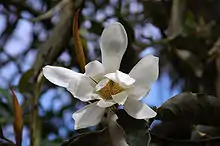Magnolia doltsopa
Magnolia doltsopa is a large shrub or small tree native to the eastern Himalayan region and the Meghalaya subtropical forests in Northeastern India.[3] The wood is fragrant.[4]
| Magnolia doltsopa | |
|---|---|
 | |
| Scientific classification | |
| Kingdom: | Plantae |
| Clade: | Tracheophytes |
| Clade: | Angiosperms |
| Clade: | Magnoliids |
| Order: | Magnoliales |
| Family: | Magnoliaceae |
| Genus: | Magnolia |
| Subgenus: | Magnolia subg. Yulania |
| Section: | Magnolia sect. Michelia |
| Subsection: | Magnolia subsect. Michelia |
| Species: | M. doltsopa |
| Binomial name | |
| Magnolia doltsopa | |
| Synonyms | |
| |
Description
The plant varies in form from bushy to narrow and upright, can grow to a height of 30 metres (98 ft) tall. The tree flowers in spring and produces heavily scented white flowers. It has long leathery and glossy dark-green leaves, 6–17 centimetres (2.4–6.7 in) in length, that provide a point of interest all year long. The wood is a rich brown.[5]
The "Silver Cloud" variety grows to 15 feet and flowers earlier in its lifespan.[6]
Cultivation
Magnolia doltsopa is used as a featured ornamental tree and street tree, or pruned as a hedge. It enjoys a sheltered position in full or part sun, and appreciates well drained soil.[7] It can tolerate acidic soil.[6]
Global distribution and use
In Nepal, the wood of the Magnolia doltsopa is used for house building.[4] It is also used for house building in Bhutan, where in the 1980s it suffered from over-harvesting.[5]
The Magnolia doltsopa is useful in a Shifting cultivation system, which relies on species with good nitrogen fixation in soil.[8]
References
- https://www.iucnredlist.org/species/193936/2291402
- http://www.theplantlist.org/tpl1.1/record/kew-252919
- Flint, Harrison L. (1997). Landscape Plants for Eastern North America: Exclusive of Florida and the Immediate Gulf Coast. John Wiley & Sons. p. 394. ISBN 9780471599197.
- Loudon, John Claudius (1838). Arboretum Et Fruticetum Britannicum. Harvard University. pp. 291.
michelia doltsopa.
- Hellum, A. K. (2001). A Painter's Year in the Forests of Bhutan. University of Alberta. p. 10. ISBN 9780888643230.
- Burke, Don (2005). The Complete Burke's Backyard: The Ultimate Book of Fact Sheets. Murdoch Books. p. 453. ISBN 9781740457392.
- Pacific Horticultural Foundation (1960). "California Horticultural Journal". California Horticultural Journal. 21–22.
- Sharma, P. D. (2009). Ecology and Environment. Rastogi Publications. p. 260. ISBN 9788171339051.
